Abstract
A case-control study of 271 men with testicular cancer and 259 controls was conducted in the Washington, DC area to evaluate whether suggested risk factors could be responsible for the epidemic increases in testicular cancer in young men. No substantial risks were associated with a history of groin hernia operation, the common childhood diseases, allergies, x rays below the waist, venereal disease, vasectomy, or external means of elevating the temperature of the testis. Excess risks were associated with a history of undescended testis (RR = 3.7, CI = 1.5-9.5), testicular trauma (RR = 2.6, CI = 1.6-4.2), and mumps orchitis (RR = 5.8, CI = 0.7-129.7). It is unlikely, however, that any of these conditions has increased sufficiently over time to markedly affect the testicular cancer incidence patterns. Therefore, while the risk factors identified in this paper are of epidemiological interest, they do not account for the increase in testicular cancer in young men.
Full text
PDF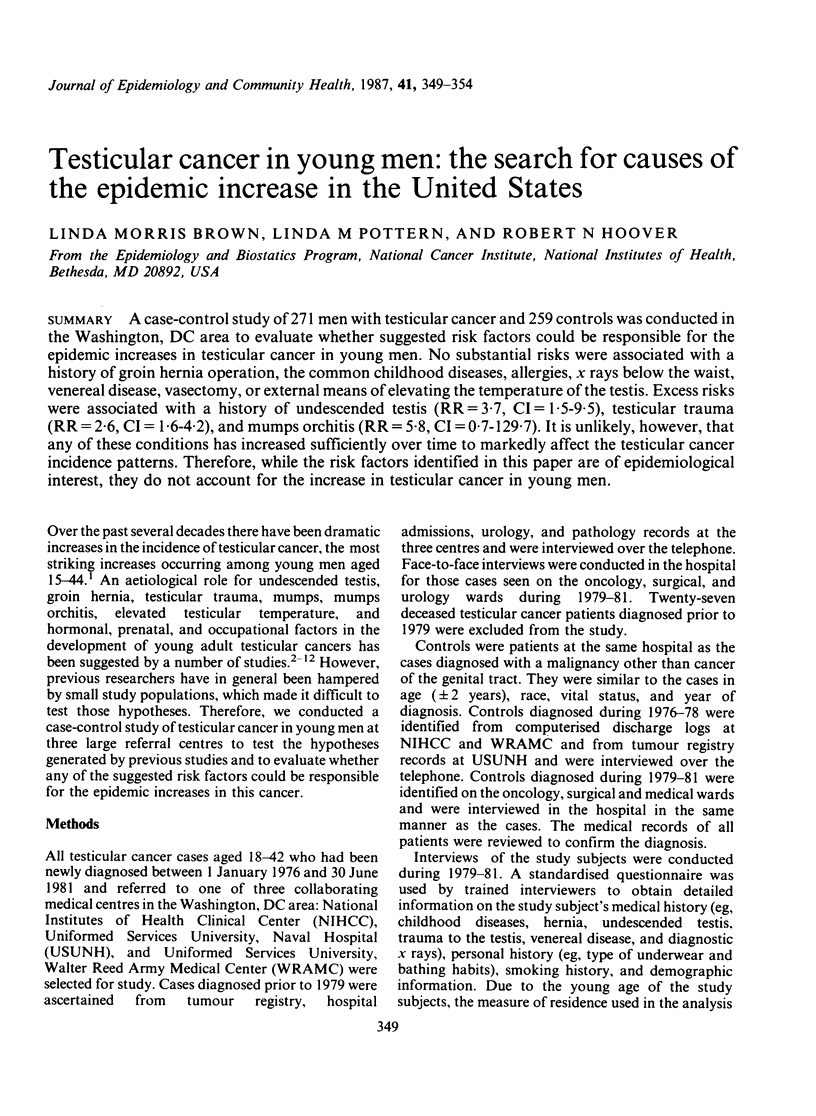
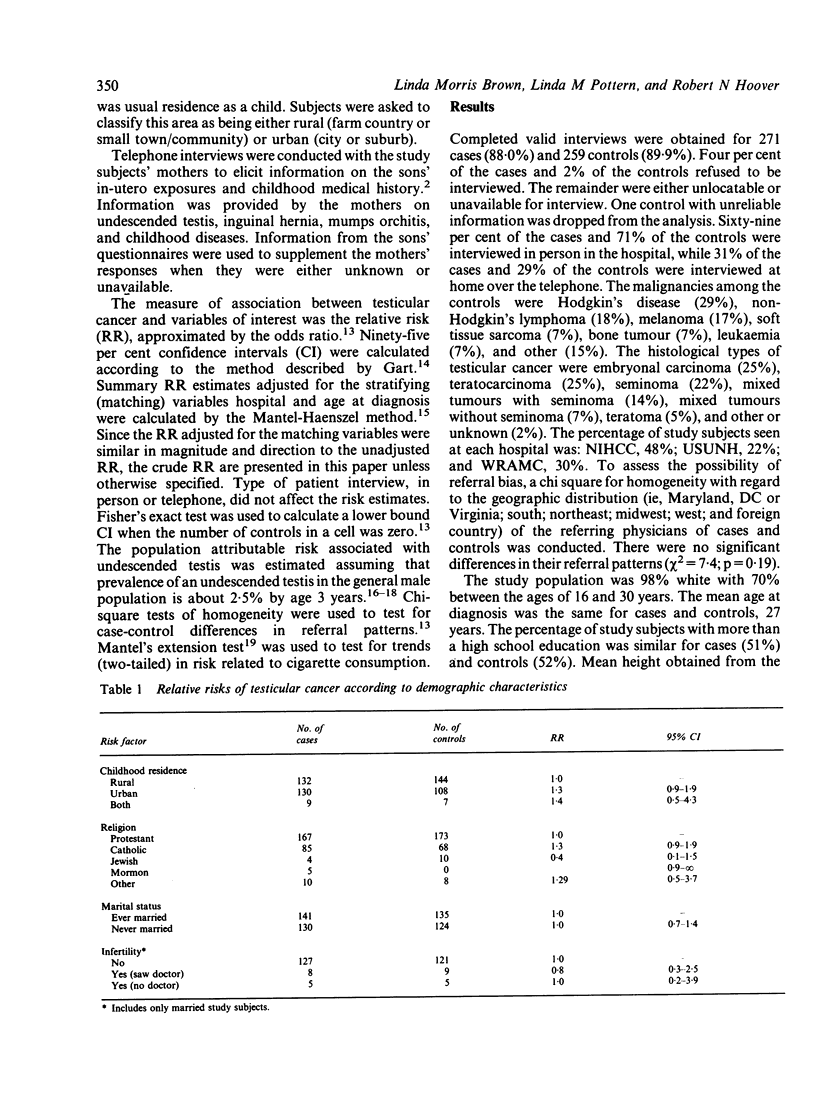
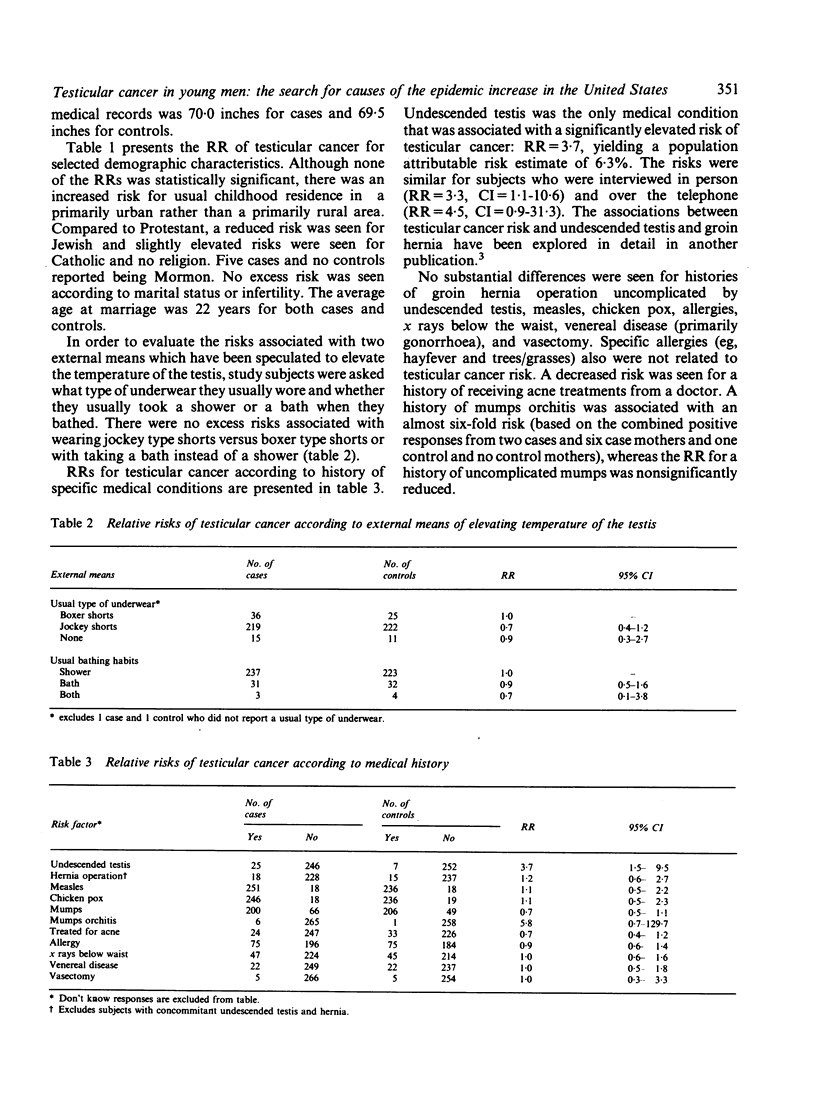
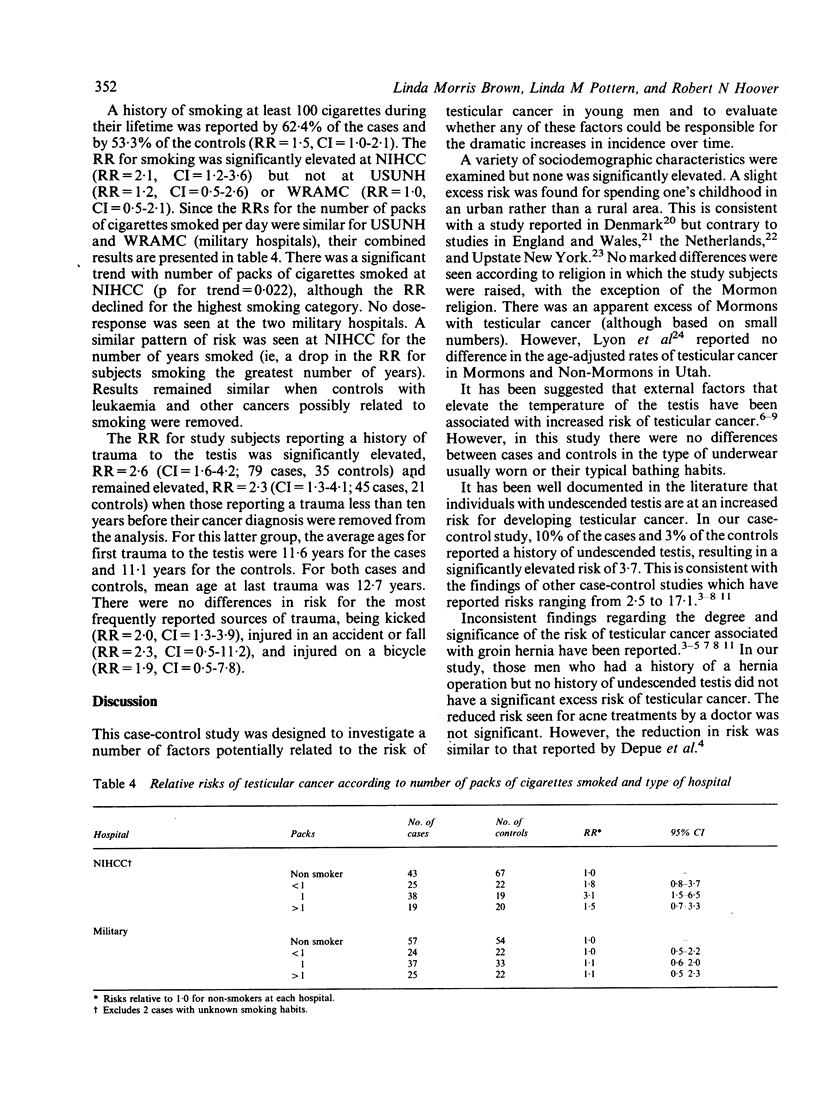
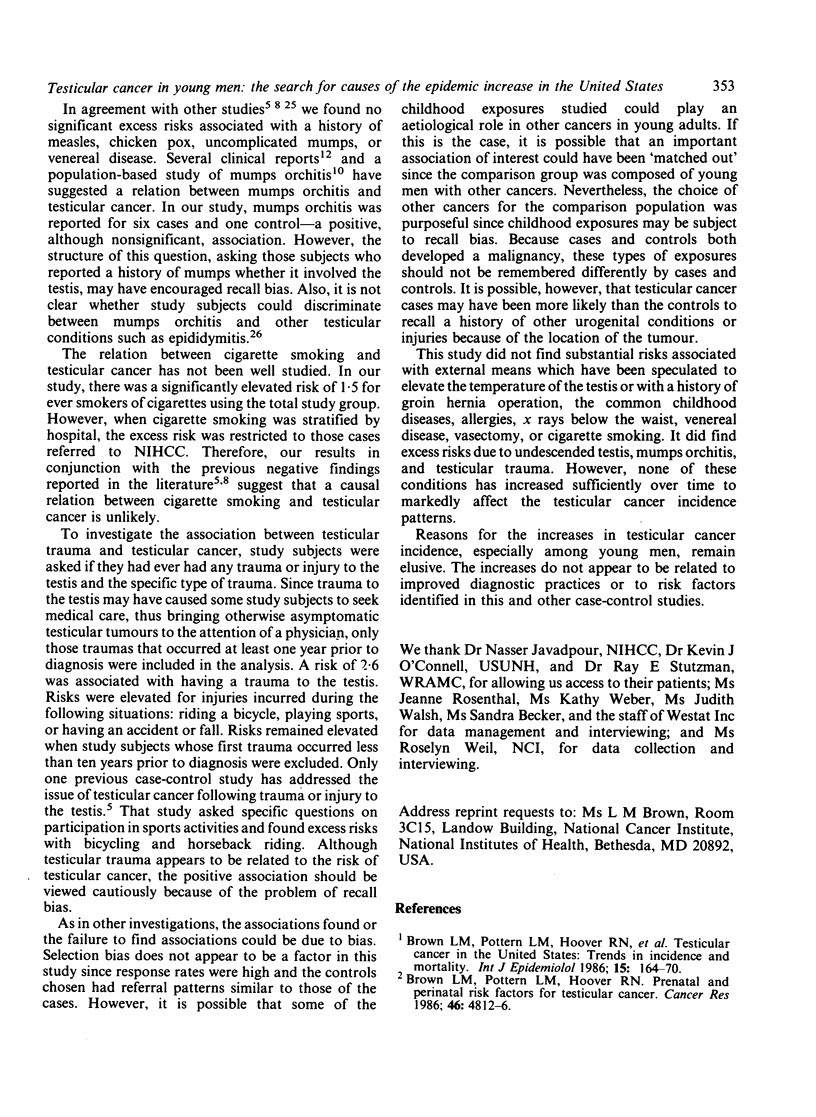
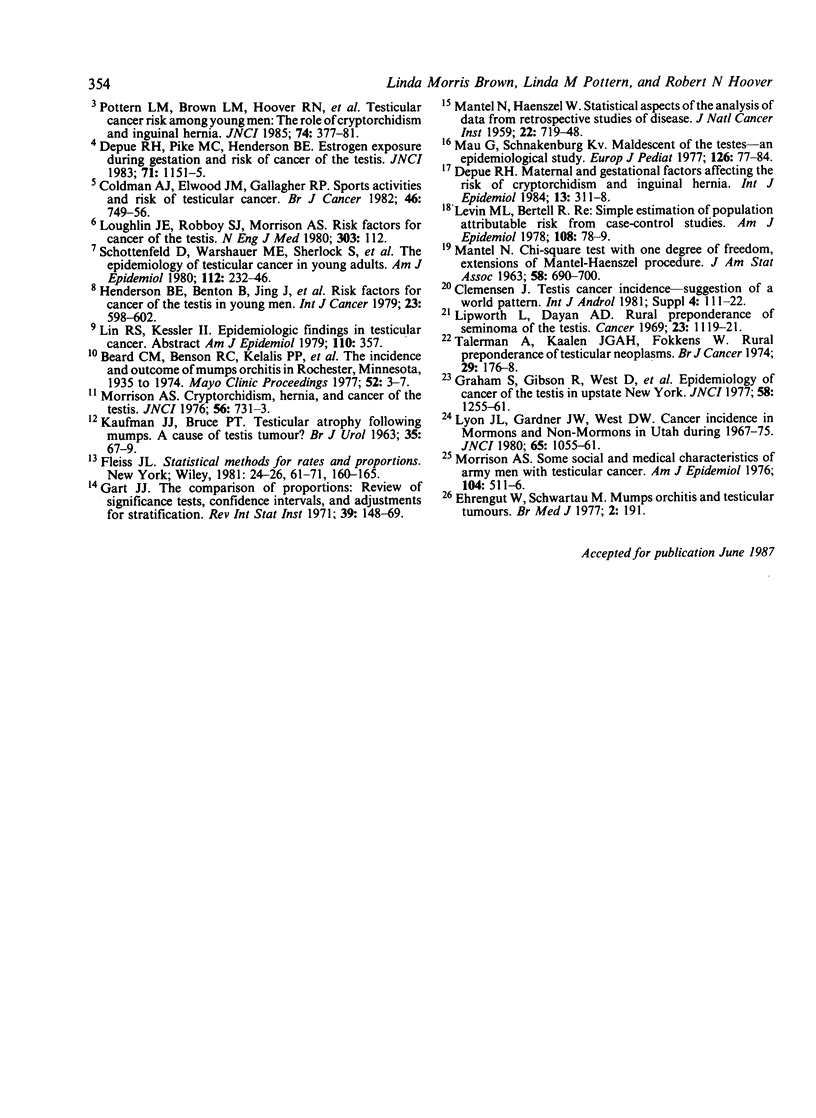
Selected References
These references are in PubMed. This may not be the complete list of references from this article.
- Beard C. M., Benson R. C., Jr, Kelalis P. P., Elveback L. R., Kurland L. T. The incidence and outcome of mumps orchitis in Rochester, Minnesota, 1935 to 1974. Mayo Clin Proc. 1977 Jan;52(1):3–7. [PubMed] [Google Scholar]
- Brown L. M., Pottern L. M., Hoover R. N., Devesa S. S., Aselton P., Flannery J. T. Testicular cancer in the United States: trends in incidence and mortality. Int J Epidemiol. 1986 Jun;15(2):164–170. doi: 10.1093/ije/15.2.164. [DOI] [PubMed] [Google Scholar]
- Brown L. M., Pottern L. M., Hoover R. N. Prenatal and perinatal risk factors for testicular cancer. Cancer Res. 1986 Sep;46(9):4812–4816. [PubMed] [Google Scholar]
- Coldman A. J., Elwood J. M., Gallagher R. P. Sports activities and risk of testicular cancer. Br J Cancer. 1982 Nov;46(5):749–756. doi: 10.1038/bjc.1982.267. [DOI] [PMC free article] [PubMed] [Google Scholar]
- Depue R. H. Maternal and gestational factors affecting the risk of cryptorchidism and inguinal hernia. Int J Epidemiol. 1984 Sep;13(3):311–318. doi: 10.1093/ije/13.3.311. [DOI] [PubMed] [Google Scholar]
- Depue R. H., Pike M. C., Henderson B. E. Estrogen exposure during gestation and risk of testicular cancer. J Natl Cancer Inst. 1983 Dec;71(6):1151–1155. [PubMed] [Google Scholar]
- Ehrengut W., Schwartau M. Mumps orchitis and testicular tumours. Br Med J. 1977 Jul 16;2(6080):191–191. doi: 10.1136/bmj.2.6080.191-a. [DOI] [PMC free article] [PubMed] [Google Scholar]
- Graham S., Gibson R., West D., Swanson M., Burnett W., Dayal H. Epidemiology of cancer of the testis in upstate New York. J Natl Cancer Inst. 1977 May;58(5):1255–1261. doi: 10.1093/jnci/58.5.1255. [DOI] [PubMed] [Google Scholar]
- Henderson B. E., Benton B., Jing J., Yu M. C., Pike M. C. Risk factors for cancer of the testis in young men. Int J Cancer. 1979 May 15;23(5):598–602. doi: 10.1002/ijc.2910230503. [DOI] [PubMed] [Google Scholar]
- KAUFMAN J. J., BRUCE P. T. Testicular atrophy following mumps. A cause of testis tumour? Br J Urol. 1963 Mar;35:67–69. doi: 10.1111/j.1464-410x.1963.tb02597.x. [DOI] [PubMed] [Google Scholar]
- Levin M. L., Bertell R. RE: "simple estimation of population attributable risk from case-control studies". Am J Epidemiol. 1978 Jul;108(1):78–79. [PubMed] [Google Scholar]
- Lipworth L., Dayan A. D. Rural preponderance of seminoma of the testis. Cancer. 1969 May;23(5):1119–1121. doi: 10.1002/1097-0142(196905)23:5<1119::aid-cncr2820230516>3.0.co;2-j. [DOI] [PubMed] [Google Scholar]
- Loughlin J. E., Robboy S. J., Morrison A. S. Risk factors for cancer of the testis. N Engl J Med. 1980 Jul 10;303(2):112–113. doi: 10.1056/NEJM198007103030218. [DOI] [PubMed] [Google Scholar]
- Lyon J. L., Gardner J. W., West D. W. Cancer incidence in Mormons and non-Mormons in Utah during 1967--75. J Natl Cancer Inst. 1980 Nov;65(5):1055–1061. [PubMed] [Google Scholar]
- MANTEL N., HAENSZEL W. Statistical aspects of the analysis of data from retrospective studies of disease. J Natl Cancer Inst. 1959 Apr;22(4):719–748. [PubMed] [Google Scholar]
- Mau G., Schnakenburg K. Maldescent of the testes--an epidemiological study. Eur J Pediatr. 1977 Aug 23;126(1-2):77–84. doi: 10.1007/BF00443125. [DOI] [PubMed] [Google Scholar]
- Morrison A. S. Cryptorchidism, hernia, and cancer of the testis. J Natl Cancer Inst. 1976 Apr;56(4):731–733. doi: 10.1093/jnci/56.4.731. [DOI] [PubMed] [Google Scholar]
- Morrison A. S. Some social and medical characteristics of Army men with testicular cancer. Am J Epidemiol. 1976 Nov;104(5):511–516. doi: 10.1093/oxfordjournals.aje.a112323. [DOI] [PubMed] [Google Scholar]
- Pottern L. M., Brown L. M., Hoover R. N., Javadpour N., O'Connell K. J., Stutzman R. E., Blattner W. A. Testicular cancer risk among young men: role of cryptorchidism and inguinal hernia. J Natl Cancer Inst. 1985 Feb;74(2):377–381. [PubMed] [Google Scholar]
- Schottenfeld D., Warshauer M. E., Sherlock S., Zauber A. G., Leder M., Payne R. The epidemiology of testicular cancer in young adults. Am J Epidemiol. 1980 Aug;112(2):232–246. doi: 10.1093/oxfordjournals.aje.a112989. [DOI] [PubMed] [Google Scholar]
- Talerman A., Kaalen J. G., Fokkens W. Rural preponderance of testicular neoplasms. Br J Cancer. 1974 Feb;29(2):176–178. doi: 10.1038/bjc.1974.54. [DOI] [PMC free article] [PubMed] [Google Scholar]


